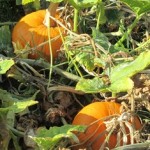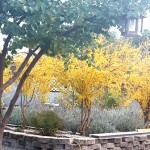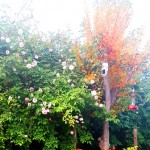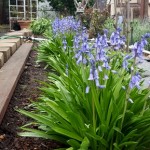Celebrate the Ever-Evolving Garden
There’s nothing to rejuvenate a weary soul like time spent in a garden. Death of one season’s plants yields to new shoots the next. Because I appreciate the ever-evolving nature of a garden, I choose plants, bulbs, bushes, and trees that offer visual interest in each season. Thoughtful planting generates an ever-evolving landscape of color, texture, and visual interest.
The autumn garden has almost completely morphed into a winter landscape now. Pumpkin and tomato vines have been pulled out and perennials in the bee garden have gone to seed or been cut back. Winter offers little color in the garden except for the cape honeysuckle, white geranium, lavender florets, and early flowering bulbs.
Deciduous trees have mostly lost their leaves, however, the eucalyptus and the pepper trees here on the farmette remain leafy and green. The rains have come and a dusting of snow on nearby mountain peaks is in the forecast ahead. Foliage and blooms are mostly gone. It’s that time of year to cover frost-sensitive plants.
The pomegranates that were ablaze in golden color a few weeks ago have dropped all leaves. What remains is the lovely arching pattern of branches since I’ve trained them from bushes into trees.
The showy pink flowers over summer of the crape myrtle are a memory. Gone now, too, are the red-gold leaves of fall. What remains is an interesting gray-green bark.
The seeds from the giant yellow-orange coreopsis that stood eight feet tall and towered over zinnias, Borage, and rows of lavender have long ago been harvested. Also, my patch of lavender is flourishing. The plants have pushed out long stalks of purple florets.
Dark green shoots of bulbs are pushing up out of the earth where I interplanted them with chrysanthemums. I cut back the mums and they will reappear in the spring to flower again. This is the time of year that shoots of bulbs and rhizomes are birthing daffodils, anemones, tulips, hyacinths, and, to come later, lilies and irises of many colors.
In raised beds, shoots of fall-planted onions and garlic are now pushing up. The bees are drawn to the sweet scent of narcissus bulbs that have naturalized after being planted years ago. The Meyer lemon now has lots of yellow thin-skinned fruit and also a few early blooms.
On the dark days and nights of winter, white blooming plants stand in stark contrast to gray wooden fences and leafless trees. Honor roses, Iceberg roses, and climbing Sally Holmes roses have showy white blooms and may even have some this time of year unless they’ve been cut back. Winter-blooming gardenias and white geraniums have a quiet impact when grouped together in hedges, beds, or containers.
With so many bulbs and plants available this time of year, putting interest into your winter garden is easy and contributes to an ever-evolving landscape.
Consider plants with gray-green or otherwise pretty foliage and colorful berries. Also plant trees with interesting bark colors, textures, patterns, or scaffolding shapes. When you think of plants for each season of the year, you’ll have a garden to nurture you throughout the year.
____________________________________________________
If you enjoy reading about gardening, the keeping of chickens and bees, and other small farm topics AND you’d like related gift-giving, consider my Henny Penny Farmette series of cozy mysteries or any of my health, wellness, and spirituality books. All are available online and in traditional bookstores everywhere.
AVAILABLE NOW. Tap control click in the following link: https://www.amazon.com/How-Live-Intention-Meaning-Purpose-ebook/dp/B07GNVFWSF/ref=sr_1_1?ie=UTF8&qid=1544206797&sr=8-1&keywords=Meera+Lester%2BHow+to+Live+with+Intention
To Purchase, tap control click on the link:
Iris Reward with Sensational Spring Blooms
Few flowers do the double duty of iris in a flower garden. They provide a great background for other flowers and also produce exquisite blooms on their tall stems. Both bearded and beardless iris plants provide textural interest for other perennials, annuals, and herbs, whether in a formal or informal flower bed, along a walkway, or tucked into a corner of a garden.
Iris produce their blooms on stalks that emerge from clumps of stiff, erect, spiked, and pointed green leaves. My iris plants were a gift from the neighbor who owns the property behind the Henny Penny Farmette. The bulbs she gave me had originally been planted by her father and mother, both now deceased. We were thrilled to get the bulbs.
When we planted them on our property, we made sure the soil was amended and we sprinkled in some bone meal and watered well. Then the iris were left alone. We did apply mulch prior to the winter rainy season and because here in the inland valley of the east bay, we can get freezing nighttime temperatures. Those iris plants have rewarded us with spectacular blooms in April each year.
We didn’t know if the bulbs would produce a true blue bloom or some other color, so the anticipation was killing us that first year. Then the buds emerged on tall (roughly three foot stalks) and we could see what was coming. I have to say, the blooms bedazzled us.
Plant height separates the bearded iris into roughly five groups: miniature dwarf, standard dwarf, intermediate, miniature tall, border, and standard tall. Our iris plants fall into the standard tall category. The best time to plant the iris rhizomes is from July to September 15. Set the rhizomes just beneath the soil surface as they do not like being planted too deep. In really cold areas, a thick layer of mulch ensures the rhizome survives alternate freezes and thaws. Lift and divide the rhizomes right after blooming. You can cut the leaves back to six inches for ease in handling the plants.
A note about rhizomes: These thick horizontal stems generate roots from the bottom and the plant’s leaves and flowers emerge from the top. Some plants that grow from rhizomes are bearded irises, calla lilies, and cannas.
 Facebook
Facebook Goodreads
Goodreads LinkedIn
LinkedIn Meera Lester
Meera Lester Twitter
Twitter














